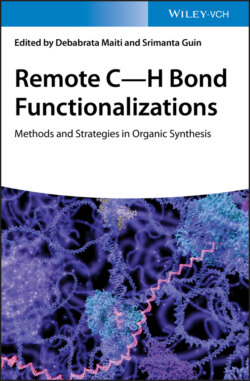Читать книгу Remote C-H Bond Functionalizations - Группа авторов - Страница 11
2.1 Introduction
ОглавлениеSite‐selective C–H functionalization has emerged as an important synthetic methodology in organic synthesis in the past two decades [1–10]. For such synthetic methodology to be synthetically useful, precise control of the site‐selectivity of C–H functionalization reactions is one of the most important issues required to be resolved due to the presence of several CH bonds with similar reactivity in an organic molecule. Notably, meta‐selectivity in C–H functionalization of arenes is one of the intriguing site selectivities that have been intensely studied in recent years [1–10]. Although thousands of methods for ortho‐C–H functionalizations of arenes via proximity‐induced cyclometallation have been reported, only a limited number of approaches have been disclosed in meta‐C–H functionalizations of arenes. One of the representative approaches of meta‐C–H functionalization of arenes is the directing template assisted remote meta‐C–H functionalizations of arenes via geometry‐induced metalation (Scheme 2.1a) [5–10].
ortho‐C–H functionalization has been usually promoted by σ‐chelation of the directing template. However, applying this chelation to meta‐C–H functionalization is much more challenging since a strained cyclophane‐like metallacycle might be involved in this transformation [11]. In 2012, the group of Yu and coworkers disclosed the first geometry‐induced remote meta‐C–H activation of toluenes and hydrocinnamic acids with a Pd(II) catalyst, which is assisted by two types of rationally designed nitrile‐based templates that are covalently linked with toluenes or hydrocinnamic acids through an ether or amide bond (Scheme 2.1b) [11]. The presumable linear coordination mode of the nitrile‐based chelating functionality (CF) in the U‐shaped template that weakly coordinates to the palladium center in an end‐on fashion is important for securing a possible less strained cyclophane‐like pre‐transition state. However, a more likely catalytic scenario is the weakly chelating template may “catch and release” the Pd(II) catalyst closely to the target meta‐CH bond, leading to a high effective concentration of the Pd(II) catalyst at the target meta‐CH bond without forming an 11‐ or 12‐membered cyclophane‐like palladacycle.
Scheme 2.1 Directing template assisted meta‐CH bond functionalization. Related reviews:
(a) Li et al. [5], Yang [6], Chattopadhyay and Bisht [7], Dey et al. [8], Ghosh and De Sarkar [9], and Dey et al. [10]; Source: (b) Modified from Leow et al. [11].
Inspired by this pioneering work, a series of directing template assisted remote meta‐C–H activation reactions have been realized for a list of substrates including acids, amines, sulfonic acids, and so on (Scheme 2.1c). Notably, one of the key features of these reactions is the target CH bond is usually 10–12 atoms away from the chelating atom of the template (Scheme 2.1b,d), although longer length was also possible. To date, three categories of CFs have been engineered including two nitrogen‐based CN‐containing (Scheme 2.2a) or heteroarene‐containing (Scheme 2.2b) CFs and one oxygen‐based CO2H‐containing CF (Scheme 2.2c). It should be noted that besides these three CFs that covalently attached to the substrate, two catalytic bifunctional templates that reversibly coordinate to the substrate were also reported recently and they are not classified in these categories [12,13]. Another key feature of these reactions is that hexafluoroisopropanol (HFIP), which could also be used as an additive, appears to be the privileged solvent. Finally, N‐acetyl glycine (Ac‐Gly‐OH), a mono‐N‐protected amino acid (MPAA), is often the ligand of choice for many of these reactions, although other MPAA ligands could also be utilized in some cases.
Herein, we summarize important achievements that were disclosed until October 2019 in the field of directing template assisted meta‐C–H functionalization of arenes with Pd or Rh catalysts since 2012. Different aspects of this type of methodology will be covered while discussing the works that are categorized by the substrate type. Important mechanistic studies on this methodology will also be included. It is hoped that the reader will learn the key points, especially structural features, for rationally designing a feasible template for new substrates as well as developing new types of meta‐C–H transformation after reading this chapter.
Scheme 2.2 Three categories of chelating functionality (CF). (a) N‐Based CN‐containing CF; (b) N‐based heteroarene‐containing CF; (c) O‐based CO2H‐containing CF.
